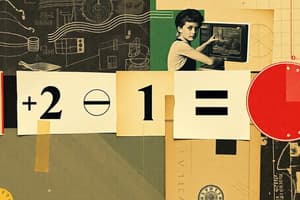Podcast
Questions and Answers
What is the sum of the fractions $\frac{3}{8} + \frac{1}{8}$?
What is the sum of the fractions $\frac{3}{8} + \frac{1}{8}$?
- $\frac{5}{8}$ (correct)
- $\frac{1}{2}$
- $\frac{4}{8}$
- $\frac{2}{4}$
What is the result of $\frac{5}{6} - \frac{2}{6}$?
What is the result of $\frac{5}{6} - \frac{2}{6}$?
- $\frac{7}{6}$
- $\frac{1}{2}$
- $\frac{3}{6}$ (correct)
- $\frac{1}{3}$
What is $\frac{2}{3} \times \frac{4}{5}$?
What is $\frac{2}{3} \times \frac{4}{5}$?
- $\frac{8}{5}$
- $\frac{6}{5}$
- $\frac{8}{15}$ (correct)
- $\frac{6}{15}$
What is $\frac{2}{7} \div \frac{1}{3}$?
What is $\frac{2}{7} \div \frac{1}{3}$?
What is the greatest common divisor (GCD) of 12 and 8?
What is the greatest common divisor (GCD) of 12 and 8?
If $\frac{10}{15}$ is simplified, what is the result?
If $\frac{10}{15}$ is simplified, what is the result?
What is the correct way to add $\frac{1}{4}$ and $\frac{1}{2}$?
What is the correct way to add $\frac{1}{4}$ and $\frac{1}{2}$?
What is the result of $\frac{5}{8} - \frac{1}{4}$?
What is the result of $\frac{5}{8} - \frac{1}{4}$?
If $\frac{9}{12}$ is simplified, what fraction do you get?
If $\frac{9}{12}$ is simplified, what fraction do you get?
What is the product of $\frac{3}{5} \times \frac{2}{3}$?
What is the product of $\frac{3}{5} \times \frac{2}{3}$?
Flashcards are hidden until you start studying
Study Notes
Solving Fractions
Addition of Fractions
- Same Denominator: Add the numerators; keep the denominator.
- Example: ( \frac{a}{c} + \frac{b}{c} = \frac{a+b}{c} )
- Different Denominators:
- Find a common denominator (LCM of the denominators).
- Adjust numerators accordingly.
- Add the adjusted numerators; keep the common denominator.
- Example: ( \frac{a}{b} + \frac{c}{d} = \frac{a \cdot d + b \cdot c}{b \cdot d} )
Subtraction of Fractions
- Same Denominator: Subtract the numerators; keep the denominator.
- Example: ( \frac{a}{c} - \frac{b}{c} = \frac{a-b}{c} )
- Different Denominators:
- Find a common denominator.
- Adjust numerators accordingly.
- Subtract the adjusted numerators; keep the common denominator.
- Example: ( \frac{a}{b} - \frac{c}{d} = \frac{a \cdot d - b \cdot c}{b \cdot d} )
Multiplication of Fractions
- Multiply the numerators together and the denominators together.
- Example: ( \frac{a}{b} \times \frac{c}{d} = \frac{a \cdot c}{b \cdot d} )
- Simplify before multiplying if possible.
Division of Fractions
- Invert the second fraction and multiply.
- Example: ( \frac{a}{b} \div \frac{c}{d} = \frac{a}{b} \times \frac{d}{c} = \frac{a \cdot d}{b \cdot c} )
- Simplify before and after dividing if possible.
Simplifying Fractions
- Finding GCD (Greatest Common Divisor):
- Identify the GCD of the numerator and denominator.
- Divide both by the GCD.
- Reducing to Lowest Terms:
- A fraction is in simplest form when the numerator and denominator have no common factors (other than 1).
- Example:
- ( \frac{8}{12} ) simplifies to ( \frac{2}{3} ) (GCD is 4).
Addition of Fractions
- For fractions with the same denominator, simply add the numerators while keeping the denominator unchanged. For instance, ( \frac{a}{c} + \frac{b}{c} = \frac{a+b}{c} ).
- To add fractions with different denominators, determine the least common multiple (LCM) of the denominators, adjust the numerators to match this common denominator, and then add the resulting numerators. Example: ( \frac{a}{b} + \frac{c}{d} = \frac{a \cdot d + b \cdot c}{b \cdot d} ).
Subtraction of Fractions
- For fractions that share the same denominator, subtract the numerators while keeping the denominator the same. For example, ( \frac{a}{c} - \frac{b}{c} = \frac{a-b}{c} ).
- For fractions with different denominators, find a common denominator, adjust the numerators correspondingly, and subtract the adjusted numerators. Example: ( \frac{a}{b} - \frac{c}{d} = \frac{a \cdot d - b \cdot c}{b \cdot d} ).
Multiplication of Fractions
- To multiply fractions, multiply the numerators together and the denominators together, yielding ( \frac{a}{b} \times \frac{c}{d} = \frac{a \cdot c}{b \cdot d} ).
- It is beneficial to simplify fractions before multiplication if possible to make calculations easier.
Division of Fractions
- Division of fractions involves inverting the second fraction and then multiplying. This can be expressed as ( \frac{a}{b} \div \frac{c}{d} = \frac{a}{b} \times \frac{d}{c} = \frac{a \cdot d}{b \cdot c} ).
- As with multiplication, simplifying fractions both before and after division can ease the process.
Simplifying Fractions
- To simplify a fraction, first find the greatest common divisor (GCD) of the numerator and denominator. Then, divide both the numerator and the denominator by the GCD.
- A fraction is considered to be in its simplest form when there are no common factors between the numerator and denominator aside from 1.
- An example of simplification: ( \frac{8}{12} ) can be reduced to ( \frac{2}{3} ) since the GCD is 4.
Studying That Suits You
Use AI to generate personalized quizzes and flashcards to suit your learning preferences.




